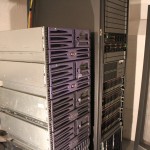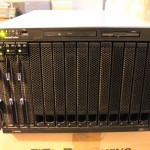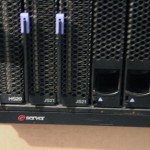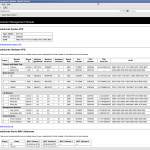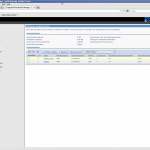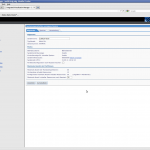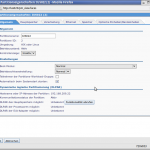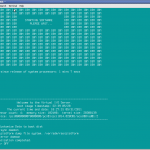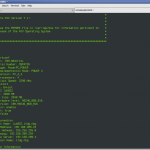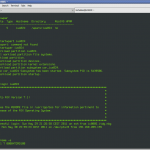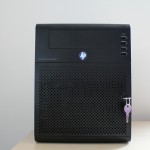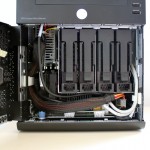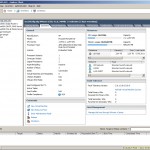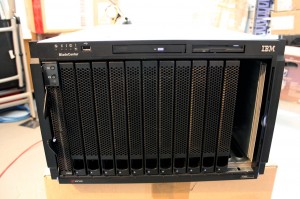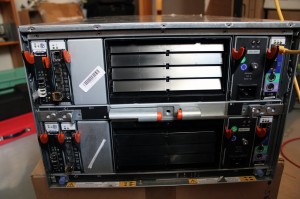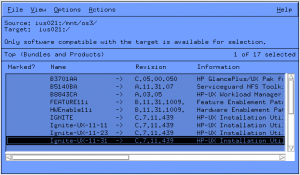Time for my first blog in 2011 ! And it’s about Sun… hoouuw hooouw… 😀
Last year a good friend gave me a Sun Fire V490. The system was new and never used but had no system board. After several months searching for an affordable system board with no success I forgot the system and payed others more attention. But a few weeks ago I got an unbelievable offer. A fully populated Sun Fire V490 with two system boards, four 1,5 Ghz UltraSPARC 4+ CPUs and 32 Gigs of RAM for only little money! Yeaaahhh…Last friday I visited the company who sold the Sun. They used the machine as a SAP test and pre-live system but changed everything to IBM Power servers. After admire their amazing new data center I put the Sun Fire V490 into my car and went home. 🙂
Because I don’t need 8 cores and 32 Gigs RAM in a single system, I installed one system board into my other new V490. 🙂 Now I have two fast and nice Sun Fire V490 servers. The UltraSPARC 4+ CPUs are amazing fast. Not comparable with US3 or US3+… I enjoy working with these two SPARC systems. Next week I will install an Oracle Database Grid (11g R2)… The first grid will use classic fibre channel SAN and my second test will use 4 Gbits ports per machine and Oracle dNFS !
Thanks to Otmanix for this incredible machine ! 🙂
And now it’s time for some pictures and console outputs. 😉
Server 1:
[root@ius096 ~]# prtdiag -v
System Configuration: Sun Microsystems sun4u Sun Fire V490
System clock frequency: 150 MHz
Memory size: 16384 Megabytes
========================= CPUs ===============================================
Run E$ CPU CPU
Brd CPU MHz MB Impl. Mask
— —– —- —- ——- —-
A 0, 16 1500 32.0 US-IV+ 2.2
A 2, 18 1500 32.0 US-IV+ 2.2
========================= Memory Configuration ===============================
Logical Logical Logical
MC Bank Bank Bank DIMM Interleave Interleaved
Brd ID num size Status Size Factor with
— — —- —— ———– —— ———- ———–
A 0 0 2048MB no_status 1024MB 8-way 0
A 0 1 2048MB no_status 1024MB 8-way 0
A 0 2 2048MB no_status 1024MB 8-way 0
A 0 3 2048MB no_status 1024MB 8-way 0
A 2 0 2048MB no_status 1024MB 8-way 0
A 2 1 2048MB no_status 1024MB 8-way 0
A 2 2 2048MB no_status 1024MB 8-way 0
A 2 3 2048MB no_status 1024MB 8-way 0
========================= IO Cards =========================
========================= Environmental Status =========================
System Temperatures (Celsius):
——————————-
Device Temperature Status
—————————————
CPU0 52 OK
CPU2 57 OK
DBP0 26 OK
=================================
Front Status Panel:
——————-
Keyswitch position: NORMAL
System LED Status:
LOCATOR FAULT POWER
——- ——- ——-
[OFF] [OFF] [ ON]
=================================
Disk Status:
————
DISK 0: [NO_FAULT]
DISK 1: [NO_FAULT]
=================================
Fan Status:
———–
Fan Tray Fan RPM Status
———– —- —– ———-
FAN_TRAY_0 CPU0_FAN 5660 [NO_FAULT]
FAN_TRAY_0 CPU1_FAN 4054 [NO_FAULT]
FAN_TRAY_0 CPU2_FAN 3947 [NO_FAULT]
FAN_TRAY_1 IO0_FAN 4054 [NO_FAULT]
FAN_TRAY_1 IO1_FAN 4166 [NO_FAULT]
=================================
Power Supplies:
—————
Supply Status Fault Fan Fail Temp Fail
—— ———— ——– ——— ———
PS0 [NO_FAULT ] OFF OFF OFF
PS1 [NO_FAULT ] OFF OFF OFF
=================================
========================= HW Revisions =======================================
System PROM revisions:
———————-
OBP 4.18.8 2006/01/19 11:19
IO ASIC revisions:
——————
Port
Model ID Status Version
——– —- —— ——-
Schizo 8 ok 7
Schizo 9 ok 7
[root@ius096 ~]# psrinfo
0 on-line since 01/30/2011 21:08:19
2 on-line since 01/30/2011 21:08:17
16 on-line since 01/30/2011 21:08:19
18 on-line since 01/30/2011 21:08:19
[locadm@ius095 ~]$ prtdiag -v
System Configuration: Sun Microsystems sun4u Sun Fire V490
System clock frequency: 150 MHz
Memory size: 16384 Megabytes
========================= CPUs ===============================================
Run E$ CPU CPU
Brd CPU MHz MB Impl. Mask
--- ----- ---- ---- ------- ----
A 0, 16 1500 32.0 US-IV+ 2.2
A 2, 18 1500 32.0 US-IV+ 2.2
========================= Memory Configuration ===============================
Logical Logical Logical
MC Bank Bank Bank DIMM Interleave Interleaved
Brd ID num size Status Size Factor with
--- --- ---- ------ ----------- ------ ---------- -----------
A 0 0 2048MB no_status 1024MB 8-way 0
A 0 1 2048MB no_status 1024MB 8-way 0
A 0 2 2048MB no_status 1024MB 8-way 0
A 0 3 2048MB no_status 1024MB 8-way 0
A 2 0 2048MB no_status 1024MB 8-way 0
A 2 1 2048MB no_status 1024MB 8-way 0
A 2 2 2048MB no_status 1024MB 8-way 0
A 2 3 2048MB no_status 1024MB 8-way 0
========================= IO Cards =========================
Bus Max
IO Port Bus Freq Bus Dev,
Type ID Side Slot MHz Freq Func State Name Model
---- ---- ---- ---- ---- ---- ---- ----- -------------------------------- ----------------------
PCI 8 A 0 66 66 1,0 ok SUNW,emlxs-pci10df,fc00/fp (fp) LP10000-S
PCI 8 A 1 66 66 2,0 ok SUNW,emlxs-pci10df,fc00/fp (fp) LP10000-S
========================= Environmental Status =========================
System Temperatures (Celsius):
-------------------------------
Device Temperature Status
---------------------------------------
CPU0 49 OK
CPU2 51 OK
DBP0 23 OK
=================================
Front Status Panel:
-------------------
Keyswitch position: NORMAL
System LED Status:
LOCATOR FAULT POWER
------- ------- -------
[OFF] [OFF] [ ON]
=================================
Disk Status:
------------
DISK 0: [NO_FAULT]
DISK 1: [NO_FAULT]
=================================
Fan Status:
-----------
Fan Tray Fan RPM Status
----------- ---- ----- ----------
FAN_TRAY_0 CPU0_FAN 5660 [NO_FAULT]
FAN_TRAY_0 CPU1_FAN 4054 [NO_FAULT]
FAN_TRAY_0 CPU2_FAN 4000 [NO_FAULT]
FAN_TRAY_1 IO0_FAN 4000 [NO_FAULT]
FAN_TRAY_1 IO1_FAN 4225 [NO_FAULT]
=================================
Power Supplies:
---------------
Supply Status Fault Fan Fail Temp Fail
------ ------------ -------- --------- ---------
PS0 [NO_FAULT ] OFF OFF OFF
PS1 [NO_FAULT ] OFF OFF OFF
=================================
========================= HW Revisions =======================================
System PROM revisions:
----------------------
OBP 4.18.8 2006/01/19 11:19
IO ASIC revisions:
------------------
Port
Model ID Status Version
-------- ---- ------ -------
Schizo 8 ok 7
Schizo 9 ok 7
Server 2:
[root@ius096 ~]# prtdiag -v
System Configuration: Sun Microsystems sun4u Sun Fire V490
System clock frequency: 150 MHz
Memory size: 16384 Megabytes
========================= CPUs ===============================================
Run E$ CPU CPU
Brd CPU MHz MB Impl. Mask
--- ----- ---- ---- ------- ----
A 0, 16 1500 32.0 US-IV+ 2.2
A 2, 18 1500 32.0 US-IV+ 2.2
========================= Memory Configuration ===============================
Logical Logical Logical
MC Bank Bank Bank DIMM Interleave Interleaved
Brd ID num size Status Size Factor with
--- --- ---- ------ ----------- ------ ---------- -----------
A 0 0 2048MB no_status 1024MB 8-way 0
A 0 1 2048MB no_status 1024MB 8-way 0
A 0 2 2048MB no_status 1024MB 8-way 0
A 0 3 2048MB no_status 1024MB 8-way 0
A 2 0 2048MB no_status 1024MB 8-way 0
A 2 1 2048MB no_status 1024MB 8-way 0
A 2 2 2048MB no_status 1024MB 8-way 0
A 2 3 2048MB no_status 1024MB 8-way 0
========================= IO Cards =========================
========================= Environmental Status =========================
System Temperatures (Celsius):
-------------------------------
Device Temperature Status
---------------------------------------
CPU0 52 OK
CPU2 57 OK
DBP0 26 OK
=================================
Front Status Panel:
-------------------
Keyswitch position: NORMAL
System LED Status:
LOCATOR FAULT POWER
------- ------- -------
[OFF] [OFF] [ ON]
=================================
Disk Status:
------------
DISK 0: [NO_FAULT]
DISK 1: [NO_FAULT]
=================================
Fan Status:
-----------
Fan Tray Fan RPM Status
----------- ---- ----- ----------
FAN_TRAY_0 CPU0_FAN 5660 [NO_FAULT]
FAN_TRAY_0 CPU1_FAN 4054 [NO_FAULT]
FAN_TRAY_0 CPU2_FAN 3947 [NO_FAULT]
FAN_TRAY_1 IO0_FAN 4054 [NO_FAULT]
FAN_TRAY_1 IO1_FAN 4166 [NO_FAULT]
=================================
Power Supplies:
---------------
Supply Status Fault Fan Fail Temp Fail
------ ------------ -------- --------- ---------
PS0 [NO_FAULT ] OFF OFF OFF
PS1 [NO_FAULT ] OFF OFF OFF
=================================
========================= HW Revisions =======================================
System PROM revisions:
----------------------
OBP 4.18.8 2006/01/19 11:19
IO ASIC revisions:
------------------
Port
Model ID Status Version
-------- ---- ------ -------
Schizo 8 ok 7
Schizo 9 ok 7
-
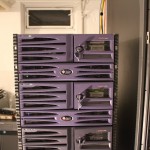
-
